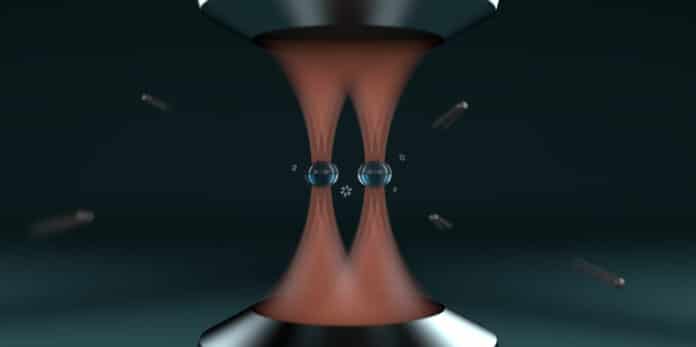Either autonomous feedback controls levitated nanoparticle motion through a cavity or measurement-based feedback through external forces. Recent experiments on measurement-based ground-state cooling of a single nanoparticle use linear velocity feedback (also known as cold damping) and ask for the application of electrostatic forces on charged particles via external electrodes.
At the Department of Information Technology and Electrical Engineering at ETH, a group of researchers under Professor Lukas Novotny have created a method to trap and cool multiple nanoparticles independently of their electric charge down to a few millikelvins.
Jayadev Vijayan, a postdoc in Novotny’s laboratory and lead author of the paper, said, “In our research group, we have perfected the cooling of single electrically charged nanoparticles over the past ten years. With the new method, which also works for electrically neutral objects, we can now trap several particles simultaneously for the first time, which opens up entirely new perspectives for research.”
In their tests, the researchers employed an optical tweezer, commonly known as a sharply concentrated laser beam, to capture a tiny glass sphere that was less than 200 nanometers in size inside of a vacuum apparatus. Due to its motional energy, the sphere oscillates back and forth inside the optical tweezer.
The amplitude of the oscillation increases with the particle’s motional energy, which increases with the particle’s temperature. A light detector, which collects the laser light scattered by the sphere, can determine how forcefully and in which direction the sphere oscillates inside the optical tweezer at any given time.
Using this information, scientists slowed down the nanoparticle and cooled it. This is accomplished by utilizing an electronically controlled deflector to slightly alter the direction of the laser beam, which in turn modifies the location of the optical tweezer by shaking it in the exact opposite direction to the oscillation of the sphere.
To counteract the sphere’s motion when it goes to the left, the tweezer is quickly switched to the right; when it moves to the right, the deflector shifts the tweezer to the left. By doing this, the oscillation’s amplitude and, consequently, its effective temperature gradually decrease, reaching a few thousandths of a degree above absolute zero (-273,15 degrees Celsius).
The scientists employed an innovative technique to chill two nanoparticles simultaneously. They tweak the optical tweezers that they use to trap the spheres such that the oscillation frequencies of the individual particles vary slightly. In this method, the two spheres’ motions can be differentiated using the same light detector, and the two tweezers can each receive a different cooling strategy.
Vijayan explains, “The simultaneous cooling can be straightforwardly scaled up to several nanoparticles. Since we have full control over the positions of the particles, we can arbitrarily tune the interactions between them; in that way, in the future, we can study quantum effects of several particles, such as entanglement.”
The study could lead to the study quantum phenomena of such particles or to build susceptible sensors.
Journal Reference:
- Vijayan, J., Zhang, Z., Piotrowski, J. et al. Scalable all-optical cold damping of levitated nanoparticles. Nat. Nanotechnol. 18, 49–54 (2023). DOI: 10.1038/s41565-022-01254-6
